11+ Sample Church Emergency Action Plan
-
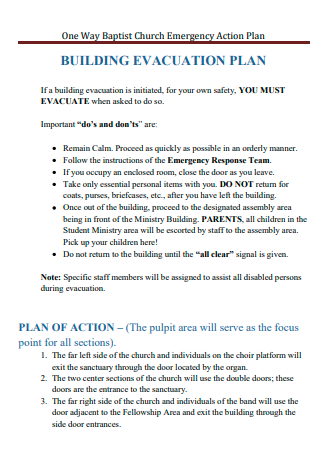
Baptist Church Emergency Action Plan
download now -
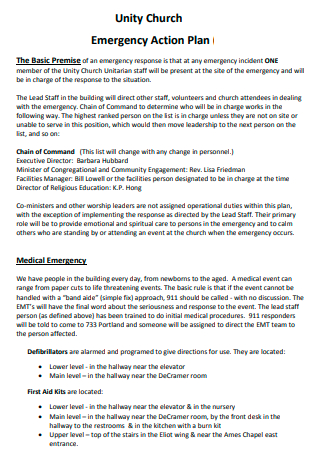
Unity Church Emergency Action Plan
download now -
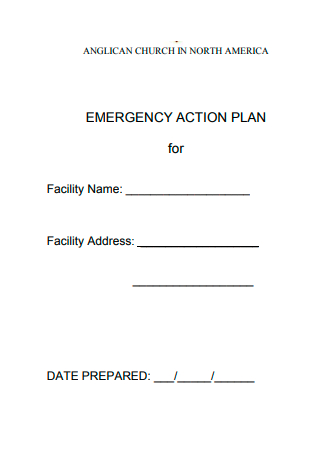
Basic Church Emergency Action Plan
download now -
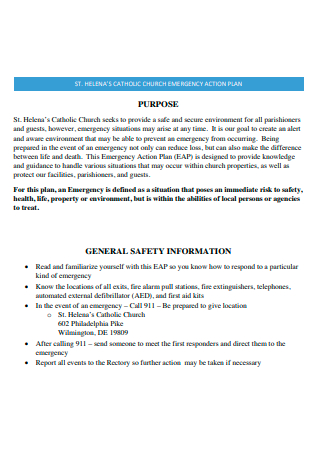
Catholic Church Emergency Action Plan
download now -

Church Emergency Action Plan in PDF
download now -
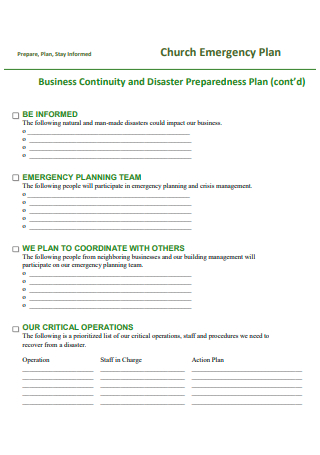
Church Emergency Action Plan Example
download now -
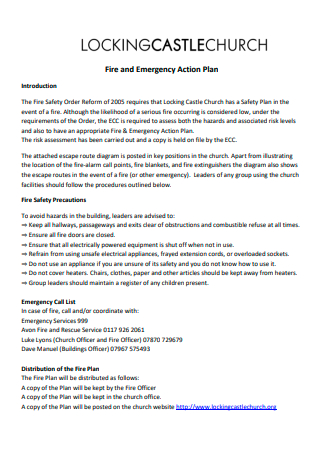
Church Fire and Emergency Action Plan
download now -
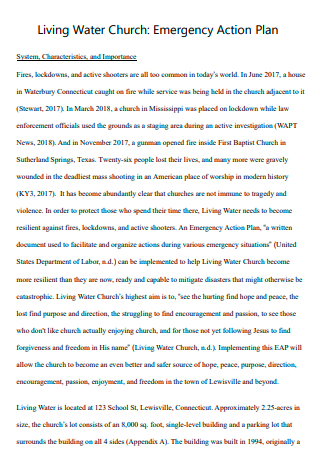
Simple Church Emergency Action Plan
download now -
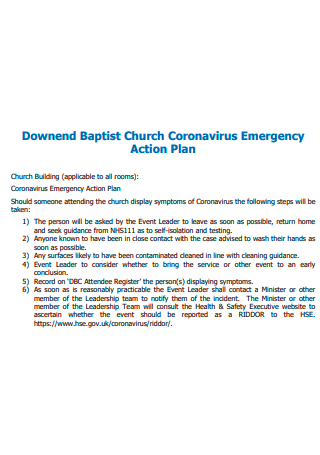
Church Coronavirus Emergency Action Plan
download now -

Standard Church Emergency Action Plan
download now -

Formal Church Emergency Action Plan
download now -
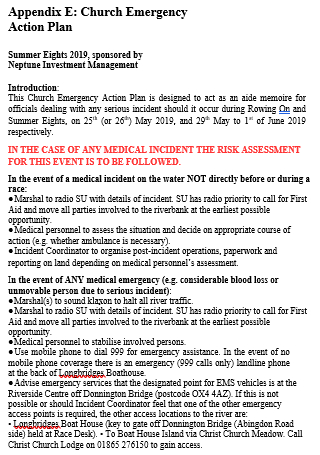
Church Emergency Action Plan in DOC
download now
FREE Church Emergency Action Plan s to Download
11+ Sample Church Emergency Action Plan
What Is a Church Emergency Action Plan?
What Should Be the First Response in A Church Emergency?
Types of Church Emergencies:
How To Create a Church Emergency Action Plan?
5 steps in a church emergency:
FAQs
How do you prepare an emergency plan?
What are your responsibilities when responding in emergency situations?
How will you assess the emergency?
What Is a Church Emergency Action Plan?
A church emergency action plan is a document that provides all the questions of what, where, when, how, and who in the case of a sudden disaster. The more detailed the plan is, the less valuable time will be lost in the event of a disaster.
This plan provides information about a common gathering place in an emergency. The action plan must take into account a potential lack of communication systems, computer systems, facility space, and churchgoers for a couple of days or weeks after a disaster. This plan requires a representative team from all parts of the church to take over reorganization.
What Should Be the First Response in A Church Emergency?
As the first part of the plan is the first response to an emergency, all of the responsible representatives of various teams must be notified about this part of the plan. This must include things like first aid, basic living necessities, and food and water. These supplies should be enough for one to survive for up to three days. Moreover, this phase also includes responses to media questions and a spokesperson who can represent the church. To implement the plan, a church mobile app or contact list can be adapted to keep communication lines open between different members of the church.
Types of Church Emergencies:
Fire And Smoke Emergencies. If you detect smoke and/or fire:
- Activate the manual fire alarm
- Initiate evacuation procedures for any congregants of the affected church
- Call 911
- Provide your name, telephone number, and location.
- Describe the situation.
- If you know how to use a fire extinguisher, locate an extinguisher and, without risking injury attempt to extinguish the fire.
- If the fire is beyond the point of a safe attempt to extinguish it, isolate the fire by closing doors in the area before evacuating.
Gas Leaks
Signs of a natural gas leak include:
- A rotten egg odor
- A blowing or hissing sound
- Dead or discolored vegetation in an otherwise green area
- Flames, if leak has ignited
- Dirt or dust blowing from a hole in the ground
- Bubbling in wet or flooded areas.
Bomb Threat
All bomb threats should be taken seriously, most threats are received by phone. Act quickly, but remain calm and obtain information.
- Remain Calm, be courteous and listen
- Try to keep the caller on the line for as long as possible
- Get attention of another person give note saying call 911 Bomb Threat
- If your phone has called ID display, record incoming phone number
- Write down exact words of the caller and threat
- Do not hang up phone, leave the line open
- Notify a church leader
- Activate fire alarm to evacuate the building
- Assist visitors out of the building and proceed to designated “Rally Zone”
- Remain in Rally Zone until all clears is issued.
Earthquake
An earthquake is one of nature’s most dangerous event, it occurs suddenly with no warning.
Before:
- Identify a safe place in work areas and church that would offer you protection from falling objects (Under desk, table, pew or inside wall).
During:
- When shaking starts Drop, Cover and Hold On.
- If there is no desk or table, sit on the floor against an interior wall away from windows, bookcases, or other tall objects that could fall on you.
After:
- After shaking stops, check yourself, fellow churchgoers, and congregation for injuries. Administer first aid to injured victims as needed.
- Conduct a safety inspection of church building for structural damage and hazards.
- If the church has sustained significant damage, consider the building unsafe and evacuate.
- Assist visitors out of the building to the designated “Rallying Zone”.
- Don’t re-entry church until building has been deemed safe
Intruder/Active Shooter Plans
When a hostile person is actively causing deadly harm or the forthcoming threat of deadly harm or is barricaded within a church, the following procedures should be followed:
- Lock yourself in the church at the time of the threatening activity.
- If communication is available, call 911 or other appropriate emergency numbers.
- Do not stay in open areas.
- Do not sound the fire alarm. A fire alarm would signal the attendees in the church to evacuate the building and thus, place them in potential harm as they attempted to exit.
- Lock the window and close blinds or curtains.
- Stay away from windows.
- Turn all lights and audio equipment off.
- Try to stay calm and be as quiet as possible.
If for some reason you are caught in an open area, such as a hallway or main congregation area, you must decide what action to take. You can try to hide, but make sure it is a well-hidden space or you may be found as the intruder moves through the church looking for victims or anyone to hostage.
If you think you can safely make it out of the building by running, then do so. If you decide to run, do not run in a straight line. Hide behind any objects or walls like doing hide and seek, except that your life is at risk. Use trees, vehicles or any other object to block you from view as you run. When away from the immediate area of danger, summon help any way you can and warn others.
If the person is causing death or serious physical injury to others and you are unable to run or hide, you may choose to play dead if other victims are around you.
The last option you have, if caught in an open area, may be to fight back. This is dangerous, but this could be an option depending on your situation.
If you are caught by the intruder and are not going to fight back, follow their directions and do not look the intruder in the eyes.
How To Create a Church Emergency Action Plan?
The emergency notification plan and preparedness manual should be introduced to staff and volunteers of the church before a disaster comes. This manual should have a couple of essential points to it.
Steps for action in a case of a disaster should identify how the organization will gather, where it will gather, and how an evacuation will proceed.
Contact information to be used in case of an emergency should be provided—this information contains who should be contacted in the case of an unexpected event as well as phone numbers of the employees, volunteers, and congregants of the church. Information systems should be backed up ahead of time and kept in a separate, safe place.
Include a detailed diagram and labeling of the building layout. Building outlines are helpful in a situation when the building needs to be evacuated quickly.
A first aid box should be kept in a safe and secure place away from the church building. It should include all the necessary things that will be needed in case something happens to the church building. This box can contain the emergency preparedness manual, contact information of all employees, backup files of data, copies of church documents, computer software copies, and basic supplies such as paper, tape, and pens.
5 steps in a church emergency:
FAQs
How do you prepare an emergency plan?
- Assemble a disaster supply kit.
- Locate safe places in your home for each type of disaster.
- Determine the best evacuation routes from your home.
- Be trained in first aid and CPR.
- Show each church member how and where to shut off utilities (water, gas, electricity).
What are your responsibilities when responding in emergency situations?
Defining what emergencies may occur and seeing that emergency measures are developed to address each situation. Directing all emergency activities, including evacuation of personnel. Ensuring that outside emergency services are notified when necessary. Directing the shutdown of church operations, when necessary.
How will you assess the emergency?
- Assess the Situation. The first thing you should do is assess the situation. Look to see who is at the emergency scene, and find out what others at the scene are doing. If anyone is in danger or hurt, you should immediately take charge of the situation. In high stress situations, people tend to panic if they or someone they know has been injured. If you feel you are able to help, take steps to lead and delegate to those around the emergency scene. Lead the people by giving them direct instructions and often they will step up and follow.
- Get Help. The first step to establishing some sort of leadership is to shout out or signal for help. Keep it simple so they can follow directions easily and so that they can snap out of any shock they may be feeling: and don’t be afraid of raising your voice. Once other bystanders are working on calling the cavalry, you can focus on the tricky task of assessing what can be done until the emergency vehicles get there.
- Assess the Injured. Perform basic triage and assess the injured people involved in the emergency situation. Look to the most vulnerable individuals first, see if you can help any of the ones with the most immediate medical needs. Preferably, you’d have an EDC bag with a first aid kit on you, or perhaps even a trauma kit in a bug out bag to use. If not, do the best you can with what you have: alcohol in your car or tearing up clothes to use as bandages would be great in these types of situations. Check for loss of consciousness, major bleeds, and asphyxiation, and deal accordingly, again, from the most to least injured. Your goal is never to completely heal victims, but to keep as many of them alive as possible until the physicians arrive. Never forget that.
- Assess the Environment. Be aware of your surroundings and of your options for making it safe, both for yourself and anyone else in the vicinity. Don’t perform first aid on an injured person right next to a burning vehicle – this seems obvious, but when there’s not much time to think, it’s possible to quickly turn an incident of one casualty to a crisis of many. Be smart and consider all of the various environmental factors involved before rushing into hero-mode.
- Know Your Limits. In periods of high pressure, it can be tempting to go beyond your knowledge or expertise to try to help, but unless you are 100% sure that you need to do something incredibly risky (like a tracheotomy) do not take the risk in doing it yourself and instead wait for professional assistance. That doesn’t mean you should watch someone suffocate when you think you could’ve helped, but if it is possible to get a person breathing by any other means, take the least risky way, or at least keep the casualty alive until the medical staff arrive and are able to do the tracheotomy themselves.
Any disaster can be natural existences such as floods, tornadoes, or earthquakes, acts of terrorism, or single armed intruders in a church. All of these sudden and unanticipated disasters can come about anywhere, including while in church, and one should be aware of this probability. The safety of the community should also be paramount even though the church has many duties and priorities. This means having a detailed plan in case of a sudden calamity. This plan needs to be prepared in detail so that if an emergency happens, everyone is prepared to act.
